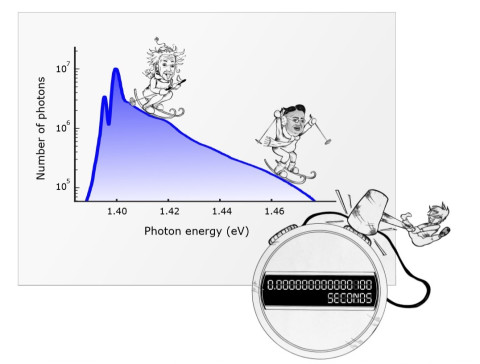Researchers at Aalto University, Finland and University of Eastern Finland have created a Bose-Einstein condensate with record speed, in about 100 femtoseconds – such time compared to one second is as short as a day compared to the age of the universe.
Bose-Einstein condensation is a quantum phenomenon where a large number of particles starts to behave as if they were one. Albert Einstein and Satyendra Nath Bose predicted this fascinating behavior in the beginning of last century. By now many different systems, for example gases of alkali atoms or semiconductors coupled with light, have been used for observing such condensates. None of them comes into being, however, as fast as the Finnish researchers’ Bose–Einstein condensate which is formed of light coupled with metal electrons in tiny metal nanodisks, interacting strongly with nearby dye molecules.
Bose-Einstein condensates composed of light are similar to lasers and particularly promising for information and quantum technologies. The information transfer of the internet today relies on the high speed of light. In principle, usage of light offers also ultrafast computing with low energy consumption, but realizing this in practice requires pushing the limits of what we know about the interaction of light with matter.
In our everyday world, water molecules of humid air condense on the surface of a cold beer can. Similarly, in the quantum world, particles have to find a way to lose their energy in order to condense to the lowest possible energy state. This process typically takes time from milliseconds to about one picosecond, that is, one trillionth of a second. How was it possible to form a condensate even ten times faster than that?
‘After carefully analyzing our measurement data, we realized that the energy relaxation in our system is a highly stimulated process. This means that the effective interaction of photons, which leads into condensation, accelerates when the number of photons increases. Such a phenomenon is the key for the speed-up,’ explains Aaro Väkeväinen who completed his PhD degree with these results. Another challenge was to prove that condensation indeed happens with record speed, since even advanced lab cameras fall short of such time resolution. ‘When we pumped energy into the molecules in 50 femtoseconds, the condensate was observed. But with 300 femtosecond pump pulse we did not see it, which indicated that the condensation must be triggered even faster,’ tells doctoral student Antti Moilanen.
‘This condensate produces a coherent light beam that is 100 000 times brighter than the first surface plasmon polariton condensate we observed in a metal nanorod array two years ago,’ comments Academy Professor Päivi Törmä. The large number of photons in the beam allows clear observation of the distribution of photons at different energies that was predicted by Bose and Einstein, as shown in the figure. ‘The brightness of the beam makes it easier to explore new areas of fundamental research and applications with these condensates,’ she continues. An invention that emerged from the condensate research of the group has just been granted a patent and will be developed further.
The results are published in the journal Nature Communications.
The research article: A.I. Väkeväinen, A.J. Moilanen, M. Nečada, T.K. Hakala, K.S. Daskalakis, P. Törmä. Sub-picosecond thermalization dynamics in condensation of strongly coupled lattice plasmons
Further information:
Päivi Törmä, Academy Professor, Aalto University
paivi.torma (a) aalto.fi
tel: +358 50 3826770 (GMT +3)
Quantum Dynamics research group
PREIN – The Academy of Finland Flagship on Photonics Research and Innovation

